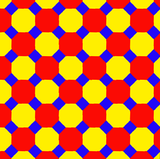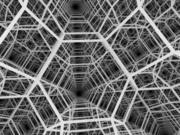截角八面体堆砌
| 截角八面体堆砌 | |
|---|---|
 | |
| 类型 | 均匀堆砌 |
| 维度 | 3 |
| 对偶多胞形 | 锲形四面体堆砌 |
| 数学表示法 | |
| 考克斯特符号 | |
| 纤维流形记号 | 8o:2 |
| 施莱夫利符号 | 2t{4,3,4} t1,2{4,3,4} |
| 性质 | |
| 胞 | (4.6.6) |
| 面 | {4} {6} |
| 组成与布局 | |
| 棱图 | {3} 等腰三角形 |
| 顶点图 |  锲形四面体 |
| 对称性 | |
| 对称群 | , [4,3,4] |
| 空间群 | Im3m (229) |
| 考克斯特群 | [[4,3,4]] |
| 特性 | |
| 顶点正 | |
在几何学中,截角八面体堆砌又称为克尔文结构是三维空间内28个半正密铺之一,由截角八面体独立堆积而成,虽然他每个胞都全等、每边皆等长,但其不能称为正密铺,因为虽然它只由一种胞,截角八面体组成,但是该胞不是正多面体,因此并非所有“面”皆全等,因此截角八面体堆砌只能称为半正堆砌。截角八面体堆砌曾出现于克尔文的研究中,克尔文指出,这种结构构成的泡沫结构可能是表面积最小的理想泡沫结构,然而1993年时物理学家丹尼斯·韦尔和罗伯特·费伦指出存在表面积更小的韦尔—费伦结构。[1]
性质[编辑]

在截角八面体堆砌中,每个顶点周围皆有有四个截角八面体,且全由截角八面体组成,因此其胞可递。它也存在边可递的特性,由于其具有2个六边形和一个正方形,且截角八面体堆砌的每个顶点都是4个截角八面体的公共顶点,因此每条边和顶点也存在点可递的特性。
截角八面体堆砌可以被视为体心立方晶格的沃罗诺伊图。开尔文男爵推测截角八面体堆砌若将其面和边弯曲且保留原来的布局将会变为最佳的肥皂泡沫理想结构[2]。而在1993年发现韦尔—费伦结构是比截角八面体堆砌更佳的泡沫结构。
命名[编辑]
康威称截角八面体堆砌为truncated octahedrille[3],在他的建筑学和反射的细分列表,与其对偶合称oblate tetrahedrille又称为锲形四面体堆砌。虽然正四面体不能单独填充整个空间,但截角八面体堆砌的对偶具有相同的锲形四面体胞与等腰三角形的面。
此外由于截角八面体堆砌的每个顶点都是4个截角八面体的公共顶点,因此也可称为四阶截角八面体堆砌。
历史[编辑]
克耳文1887年提出了一个问题:如何将空间划分为等一系列体积的胞,且每个胞的表面积最小。简而言之,效率最高的泡沫结构是什么?[2]这个问题被称为克耳文问题。
克耳文提出了一种基于截角八面体堆砌的泡沫结构,因此截角八面体堆砌又被称为克耳文结构。截角八面体堆砌是一种由截角八面体独立填满三维空间的几何结构,是凸均匀堆砌体的一种,其中截角八面体是一个空间填充十四面体,由6个正方形面和8个正六边形面组成。为了使其符合泡沫的经验定律普拉托定律[4][5],克耳文结构中的截角八面体之六边形面有略微弯曲。不过这个被认为是最佳的泡沫结构于100年后才发现反例,该反例为韦尔—费伦结构[1],其表面积比克耳文结构还要小0.3%。2009年,鲁格罗・加布里埃利(Ruggero Gabbrielli)[6]发表了一种使用斯威夫特–奥昂贝格方程在最小曲面上找到克耳文问题候选解的方法。[7][8]
对称性与表面涂色[编辑]
| 空间群 | Im3m (229) | Pm3m (221) | Fm3m (225) | F43m (216) | Fd3m (227) |
|---|---|---|---|---|---|
| 纤维流形 | 8o:2 | 4−:2 | 2−:2 | 1o:2 | 2+:2 |
| 考克斯特群 | ×2 [[4,3,4]] =[4[3[4]]] |
[4,3,4] =[2[3[4]]] |
[4,31,1] =<[3[4]]> |
[3[4]] |
×2 [[3[4]]] =[[3[4]]] |
| 考克斯特符号 | |||||
| 截角八面体 | 1 |
1:1 |
2:1:1 |
1:1:1:1 |
1:1 |
| 顶点图 | 
|

|

|

|

|
| 顶点 值 对称性 |
[2+,4] (order 8) |
[2] (order 4) |
[ ] (order 2) |
[ ]+ (order 1) |
[2]+ (order 2) |
| 图像 表面依胞 上色 |

|

|

|

|

|
相关多面体和镶嵌[编辑]

考克斯特群[4,3,4]、![]()
![]()
![]()
![]()
![]()
![]()
![]() 产生15个排列均匀的镶嵌中,9个具有独特的的几何形状,包括交错立方体堆砌、扩展立方堆砌是几何上相同的立方体堆砌。
产生15个排列均匀的镶嵌中,9个具有独特的的几何形状,包括交错立方体堆砌、扩展立方堆砌是几何上相同的立方体堆砌。
| 空间群 | 纤维流形 | 扩展 对称群 |
扩展 标记 |
阶 | 蜂巢体 (堆砌) |
|---|---|---|---|---|---|
| Pm3m (221) |
4−:2 | [4,3,4] | ×1 | ||
| Fm3m (225) |
2−:2 | [1+,4,3,4] ↔ [4,31,1] |
↔ |
Half | |
| I43m (217) |
4o:2 | [[(4,3,4,2+)]] | Half × 2 | ||
| Fd3m (227) |
2+:2 | [[1+,4,3,4,1+]] ↔ [[3[4]]] |
↔ |
Quarter × 2 | |
| Im3m (229) |
8o:2 | [[4,3,4]] | ×2 |
考克斯特群[4,31,1], ![]()
![]()
![]()
![]()
![]() , 考克斯特群产生 9个排列均匀的镶嵌中,其中4个具有独特的的几何形状,包括交替立方体堆砌。
, 考克斯特群产生 9个排列均匀的镶嵌中,其中4个具有独特的的几何形状,包括交替立方体堆砌。
| 空间群 | 纤维流形 | 扩展 对称群 |
扩展 标记 |
阶 | 蜂巢体 (堆砌) |
|---|---|---|---|---|---|
| Fm3m (225) |
2−:2 | [4,31,1] ↔ [4,3,4,1+] |
↔ |
×1 | |
| Fm3m (225) |
2−:2 | <[1+,4,31,1]> ↔ <[3[4]]> |
↔ |
×2 | |
| Pm3m (221) |
4−:2 | <[4,31,1]> | ×2 |
立方体堆砌是考克斯特群中的五个结构特别的均匀堆砌[9]之一,其对称性可以乘以环在考克斯特-迪肯符号的对称性:
| 空间群 | 纤维流形 | 方形 对称群 |
扩展 对称群 |
扩展 标记 |
扩展 阶 |
蜂巢体 (堆砌) |
|---|---|---|---|---|---|---|
| F43m (216) |
1o:2 | a1 | [3[4]] | ×1 | (None) | |
| Fd3m (227) |
2+:2 | p2 | [[3[4]]] | ↔ |
×2 | |
| Fm3m (225) |
2−:2 | d2 | <[3[4]]> ↔ [4,3,31,1] |
↔ |
×2 | |
| Pm3m (221) |
4−:2 | d4 | [2[3[4]]] ↔ [4,3,4] |
↔ |
×4 | |
| Im3m (229) |
8o:2 | r8 | [4[3[4]]] ↔ [[4,3,4]] |
↔ |
×8 |
交错形式[编辑]
截角八面体堆砌可以交错,从截角八面体的空隙中创建不规则四面体单元建立正二十面体。有三个相关的结构对应三种考克斯特—迪肯符号:![]()
![]()
![]()
![]()
![]()
![]()
![]() 、
、![]()
![]()
![]()
![]()
![]() 和
和![]()
![]()
![]()
![]()
![]() ,且有对称性[4,3+,4]、[4,(31,1)+]和[3[4]]+。第一个和最后一个的对称性为[[4,3+,4]] and [[3[4]]]+的一倍。
,且有对称性[4,3+,4]、[4,(31,1)+]和[3[4]]+。第一个和最后一个的对称性为[[4,3+,4]] and [[3[4]]]+的一倍。
截角八面体堆砌可以当作在α-rhombihedral晶体内的硼原子位置,在二十面体的中心是面心立方晶格的位置。[10]
| 空间群 | I3 (204) | Pm3 (200) | Fm3 (202) | Fd3 (203) | F23 (196) |
|---|---|---|---|---|---|
| 纤维流形 | 8−o | 4− | 2− | 2o+ | 1o |
| 考克斯特群 | [[4,3+,4]] | [4,3+,4] | [4,(31,1)+] | [[3[4]]]+ | [3[4]]+ |
| 考克斯特符号 | |||||
| 阶 | 二 | 全 | 半 | 四分之一 二 |
四分之一 |
折叠投影[编辑]
| 考克斯特群 | ||
|---|---|---|
| 考克斯特 记号 |
||
| 形状 |  过截角正方体堆砌 |
 截角正方形镶嵌 |
参见[编辑]
参考文献[编辑]
- ^ 1.0 1.1 Wearie-Phelan Bubbles. steelpillow.com. [2019-09-29]. (原始内容存档于2019-08-06).
- ^ 2.0 2.1 Lord Kelvin (Sir William Thomson), On the Division of Space with Minimum Partitional Area (PDF), Philosophical Magazine, 1887, 24 (151): 503 [2019-09-29], doi:10.1080/14786448708628135, (原始内容 (PDF)存档于2021-11-26).
- ^ John H. Conway, Heidi Burgiel, Chaim Goodman-Strauss, (2008) The Symmetries of Things, ISBN 978-1-56881-220-5 (Chapter 21, Naming the Archimedean and Catalan polyhedra and tilings, Architectonic and Catoptric tessellations, p 292-298, includes all the nonprismatic forms)
- ^ Jean E. Taylor. "The Structure of Singularities in Soap-Bubble-Like and Soap-Film-Like Minimal Surfaces". Annals of Mathematics, 2nd Ser., Vol. 103, No. 3. May, 1976, pp. 489–539.
- ^ Frederick J. Almgren Jr and Jean E. Taylor, “The geometry of soap films and soap bubbles”, Scientific American, vol. 235, pp. 82–93, July 1976.
- ^ Gabbrielli, Ruggero. Ruggero Gabbrielli - Google Scholar Citations. scholar.google.com.
- ^ Gabbrielli, Ruggero. A new counter-example to Kelvin's conjecture on minimal surfaces. Philosophical Magazine Letters. 2009-08-01, 89 (8): 483–491. ISSN 0950-0839. doi:10.1080/09500830903022651.
- ^ Freiberger, Marianne. Kelvin's bubble burst again | plus.maths.org. Plus Magazine (University of Cambridge). 2009-09-24 [2017-07-04]. (原始内容存档于2019-09-29) (英语).
- ^ [1] (页面存档备份,存于互联网档案馆), A000029 (页面存档备份,存于互联网档案馆) 6-1 cases, skipping one with zero marks
- ^ Williams, Robert. The Geometrical Foundation of Natural Structure: A Source Book of Design. Dover Publications, Inc. 1979. ISBN 0-486-23729-X., p 199, Figure 5-38.
- John H. Conway, Heidi Burgiel, Chaim Goodman-Strauss, (2008) The Symmetries of Things, ISBN 978-1-56881-220-5 (Chapter 21, Naming the Archimedean and Catalan polyhedra and tilings, Architectonic and Catoptric tessellations, p 292-298, includes all the nonprismatic forms)
- George Olshevsky, Uniform Panoploid Tetracombs, Manuscript (2006) (Complete list of 11 convex uniform tilings, 28 convex uniform honeycombs, and 143 convex uniform tetracombs)
- Branko Grünbaum, Uniform tilings of 3-space. Geombinatorics 4(1994), 49 - 56.
- Kaleidoscopes: Selected Writings of H.S.M. Coxeter, edited by F. Arthur Sherk, Peter McMullen, Anthony C. Thompson, Asia Ivic Weiss, Wiley-Interscience Publication, 1995, ISBN 978-0-471-01003-6 [2] (页面存档备份,存于互联网档案馆)
- (Paper 22) H.S.M. Coxeter, Regular and Semi Regular Polytopes I, [Math. Zeit. 46 (1940) 380-407, MR 2,10] (1.9 Uniform space-fillings)
- A. Andreini, Sulle reti di poliedri regolari e semiregolari e sulle corrispondenti reti correlative (On the regular and semiregular nets of polyhedra and on the corresponding correlative nets), Mem. Società Italiana della Scienze, Ser.3, 14 (1905) 75–129.
外部链接[编辑]
- Klitzing, Richard. 3D Euclidean Honeycombs o4x3x4o - batch - O16. bendwavy.org.
- Uniform Honeycombs in 3-Space: 05-Batch (页面存档备份,存于互联网档案馆)
- 埃里克·韦斯坦因. Space-filling polyhedron. MathWorld.






